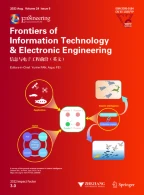Abstract
Decision modeling is an essential part of the combat system effectiveness simulation (CoSES), which needs to cope with the cognitive quality, diversity, flexibility, and higher abstraction of decision making. In this paper, a multi-paradigm decision modeling framework is proposed to support decision modeling at three levels of abstraction based on domain-specific modeling (DSM). This framework designs a domain-specific modeling language (DSML) for decision modeling to raise the abstraction level of modeling, transforms the domain-specific models to formalism-based models to enable formal analysis and early verification and validation, and implements the semantics of the DSML based on a Python scripts framework which incorporates the decision model into the whole simulation system. The case study shows that the proposed approach incorporates domain expertise and facilitates domain modeler’s participation in CoSES to formulate the problem using DSML in the problem domain, and enables formal analysis and automatic implementation of the decision model in the solution domain.
Similar content being viewed by others
References
Balasubramanian, D., Narayanan, A., van Buskirk, C., Karsai, G., 2006. The Graph Rewriting and Transformation Language: GReAT. Proc. 3rd Int. Workshop on Graph Based Tools, 1:1–8.
Chen, K., Sztipanovits, J., Neema, S., 2005. Toward a Semantic Anchoring Infrastructure for Domain-Specific Modeling Languages. Proc. 5th ACM Int. Conf. on Embedded Software, p.35–43. [doi:10.1145/1086228.1086236]
Davis, J., 2003. GME: the Generic Modeling Environment. Proc. 18th Annual ACM SIGPLAN Conf. on Objectoriented Programming, Systems, Languages, and Applications, p.82–83.
Davis, P.K., Bigelow, J.H., 1998. Experiments in Multiresolution Modeling (MRM). RAND Co., Santa Monica, CA.
Ferayorni, A.E., Sarjoughian, H.S., 2007. Domain Driven Simulation Modeling for Software Design. Proc. 2007 Summer Computer Simulation Conf., p.297–304.
France, R., Rumpe, B., 2005. Domain specific modeling. Softw. Syst. Model., 4(1):1–3. [doi:10.1007/s10270-005-0078-1]
Hemingway, G., Neema, H., Nine, H., Sztipanovits, J., Karsai, G., 2012. Rapid synthesis of high-level architecture-based heterogeneous simulation: a model-based integration approach. Simulation, 88(2):217–232. [doi:10.1177/0037549711401950]
Li, F., Shen, X., 2010. A component-based aircraft instrument rapid modeling tool. J. Zhejiang Univ.-Sci. C (Comput. & Electron.), 11(11):911–918. [doi: 10.1631/jzus.C1001010]
Li, Q., Lei, Y., Hou, H., Wang, W., 2010. Simulation Model Portability Standard 2 and Its Application. Publishing House of Electronics Industry, Beijing, China, p.344 (in Chinese).
Li, X., Lei, Y., Vangheluwe, H., Wang, W., Li, Q., 2011. Towards a DSM-based Framework for the Development of Complex Simulation Systems. Proc. 2011 Summer Computer Simulation Conf., p.210–215.
Li, X., Lei, Y., Vangheluwe, H., Wang, W., Li, Q., 2013. Domain specific decision modelling and statistical analysis for combat system effectiveness simulation. J. Stat. Comput. Simul., in press. [doi:10.1080/00949655.2013.797421]
Liu, H., Shi, Z., 2010. Intelligent Decision-Making Modeling Based on Object-Oriented Bayesian Network. Proc. 3rd Int. Conf. on Information and Computing, p.300–303. [doi:10.1109/ICIC.2010.347]
Liu, L., 2007. Research on Modeling Fleet Cooperation Decision-Making System Based on Colored Petri Net. Master Thesis, Xidian University, Xi’an, China (in Chinese).
Mittal, S., Douglass, S.A., 2011. From Domain Specific Languages to DEVS Components: Application to Cognitive M&S. Proc. Symp. on Theory of Modeling & Simulation: DEVS Integrative M&S Symp., p.256–265.
Mittal, S., Risco-Martín, J.L., Zeigler, B.P., 2007. DEVSML: Automating DEVS Execution over SOA Towards Transparent Simulators. DEVS Integrative M&S Symp., p.1–9.
Mosterman, P.J., Vangheluwe, H., 2004. Computer automated multi-paradigm modeling: an introduction. Simulation, 80(9):432–450. [doi:10.1177/0037549704050532]
Murata, T., 1989. Petri nets: properties, analysis and applications. Proc. IEEE, 77(4):541–580. [doi:10.1109/5.24143]
Neema, H., Nine, H., Hemingway, G., Sztipanovits, J., Karsai, G., 2009. Rapid Synthesis of Multi-model Simulations for Computational Experiments in C2. Armed Forces Communications and Electronics Association-George Mason University Symp.
Ratzer, A.V., Wells, L., Lassen, H.M., Laursen, M., Qvortrup, J.F., Stissing, M.S., Westergaard, M., Christensen, S., Jensen, K., 2003. CPN tools for editing, simulating, and analysing coloured Petri nets. LNCS, 2679:450–462. [doi:10.1007/3-540-44919-1_28]
Sarjoughian, H., Huang, D., 2005. A Multi-formalism Modeling Composability Framework: Agent and Discrete-Event Models. 9th IEEE Int. Symp. on Distributed Simulation and Real-Time Applications, p.249–256. [doi:10.1109/DISTRA.2005.4]
Sarjoughian, H.S., Zeigler, B.P., 2000. DEVS and HLA: complementary paradigms for modeling and simulation? Simulation, 17(4):187–196.
Seo, K.M., Song, H.S., Kwon, S.J., Kim, T.G., 2011. Measurement of effectiveness for an anti-torpedo combat system using a discrete event systems specification-based underwater warfare simulator. J. Def. Model. Simul., 8(3):157–171. [doi:10.1177/1548512910390245]
Sokolowski, J.A., 2003. Enhanced decision modeling using multiagent system simulation. Simulation, 79(4):232–242. [doi:10.1177/0037549703038886]
Son, M., Kim, T., 2012a. Torpedo evasion simulation of underwater vehicle using fuzzy-logic-based tactical decision making in script tactics manager. Expert Syst. Appl., 39(9): 7995–8012. [doi:10.1016/j.eswa.2012.01.113]
Son, M., Kim, T., 2012b. Maneuvering control simulation of underwater vehicle based on combined discrete-event and discrete-time modeling. Expert Syst. Appl., 39(17): 12992–13008. [doi:10.1016/j.eswa.2012.05.099]
Son, M.J., Cho, D.Y., Kim, T., Lee, K.Y., Nah, Y.I., 2010. Modeling and simulation of target motion analysis for a submarine using a script-based tactics manager. Adv. Eng. Softw., 41(3):506–516. [doi:10.1016/j.advengsoft.2009.10.009]
Sprinkle, J., Rumpe, B., Vangheluwe, H., Karsai, G., 2011. 3 Metamodelling. LNCS, 6100:57–76. [doi:10.1007/978-3-642-16277-0_3]
US Army Space and Missile Defense Command, 2012. EADSIM Executive Summary. Available from http://www.eadsim.com/EADSIMExecSum.pdf/ [Accessed on Apr. 21, 2013].
Verbraeck, A., Valentin, E.C., 2008. Design Guidelines for Simulation Building Blocks. Proc. Winter Simulation Conf., p.923–932.
Walter, T., Ebert, J., 2009. Combining DSLs and Ontologies Using Metamodel Integration. Proc. Working Conf. of Domain-specific Languages, p.148–169.
Wang, W., Wang, W., Zander, J., Zhu, Y., 2009. Threedimensional conceptual model for service-oriented simulation. J. Zhejiang Univ.-Sci. A, 10(8):1075–1081. [doi: 10.1631/jzus.A0920258]
Author information
Authors and Affiliations
Corresponding author
Additional information
Project (Nos. 61273198, 91024015, 61074107, 60974073, 60974074, and 71031007) supported by the National Natural Science Foundation of China
Rights and permissions
About this article
Cite this article
Li, Xb., Lei, Yl., Vangheluwe, H. et al. A multi-paradigm decision modeling framework for combat system effectiveness measurement based on domain-specific modeling. J. Zhejiang Univ. - Sci. C 14, 311–331 (2013). https://doi.org/10.1631/jzus.C1200374
Received:
Accepted:
Published:
Issue Date:
DOI: https://doi.org/10.1631/jzus.C1200374
Key words
- Multi-paradigm modeling (MPM)
- Decision modeling
- Domain-specific modeling (DSM)
- Effectiveness measurement
- Model transformation
